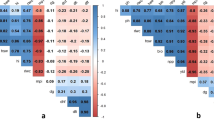Summary
Expectations of yield improvement in environments where drought was the major environmental factor limiting yields were studied in two species of rapeseed. Selection for yield in a drought stressed environment was predicted to be a more efficient selection stategy for yield improvement in dryland situations than selection in a more optimal environment, or selection based on a drought response index. The results indicate that selection for yield in a stressed environment are expected to lead to genetic advances in yield under optimal conditions as well as in a drought index. Selection under well watered conditions, on the other hand, was also expected to lead to correlated increases in yield in droughted environments but to decreases in the drought index. These results were found in both species of rapeseed grown in different water stress situations.
The genetic advance in a drought response index was predicted to be greater in B. napus and marginally less in B. campestris if selection was practised for yield in a stressed environment rather than direct selection for the drought index. This was due to the higher heritability estimates in the stressed environments and the positive genetic correlations with yield.
Similar content being viewed by others
References
Arnon, I., 1972. Crop production in dry regions. Vol. I Background and principles. Leonard Hill, London. p. 279.
Asana, R. O., 1962. Analysis of drought resistance in wheat. Arid Zone Res. UNESCO 16: 183.
Blum, A., 1973. Components analysis of yield responses to drought of sorghum hybrids. Expl. Agric 9: 159–167.
Comstock, R. E. & H. F., Robinson, 1952. Estimation of average dominance of genes. In: Gowen, J. W. (Ed.), Heterosis. Iowa State College Press, Ames, Iowa pp. 494–516.
Daday, H., F. E., Binet, A., Grassia & J. W., Peak, 1973. The effect of environment on heritability and predicted selection response in Medicago sativa. Hered. 31: 293–308.
Falconer, D. S., 1960. Introduction to quantitative genetics. Oliver and Boyd, Edinburgh.
Frey, K. J., 1964. Adaptation reaction of oat strains selected under stress and non-stress environmental conditions. Crop Sci., 4: 55–58.
Hurd, E. A., 1969. A method of breeding for yield of wheat in semiarid climates. Euphytica 18: 217–226.
Hurd, E. A., 1971. Can we breed for drought resistance? In: Larson, K. L. & J. D. Eastin (Ed.), Drought injury and resistance in crops. Crop Sci. Soc. of Am., Madison, Publ. No. 2, pp. 77–88.
Hurd, E. A., 1976. Plant breeding for drought resistance. In: Kozlowski, T. T. (Ed.), Water deficits and plant growth. Acad. Press. N.Y. Vol. 4 pp. 137–353.
Johnson, G. R. & K. J., Frey, 1967. Heritabilities of quantitative attributes of oats (Avena sp.) at varying levels of environmental stresses. Crop Sci. 7: 43–46.
Laing, D. R. & R. A., Fischer, 1977. Adaptation of semidwarf wheat cultivars to rainfed conditions. Euphytica 26: 129–139.
Levitt, J., 1951. Frost, drought and heat resistance. Ann. Rev. Pl. Physiol. 2: 24–58.
Mederski, H. J. & D. L., Jeffers, 1973. Yield response of soybean varieties grown at two soil moisture stress levels. Agron. J. 65: 410–412.
Richards, R. A., 1978. Variation between and within species of rapeseed (Brassica campestris and B. napus) in response to drought stress III. Physiological and physico-chemical characters. Aust. J. agric. Sci. 29 (In press).
Richards, R. A. & N. Thurling, 1978a. Variation between and within species of rapeseed (Brassica campestris and B. napus) in response to drought stress. I. Sensitivity at different stages of development. Aust. J. agric. Sci. 29 (In press).
Richards, R. A. & N. Thurling, 1978b. Variation between and within species of rapeseed (Brassica campestris and B. napus) in response to drought stress. II. Growth and development under natural drought stresses. Aust. J. agric. Sci. 29 (In press).
Roy, N. N. & B. R., Murty, 1970. A selection procedure in wheat for stress environment. Euphytica. 19: 509–521.
Walton, P. D., 1968. Spring wheat variety trials in the Prairie Provinces. Can. J. Pl. Sci. 48: 601–609.
Author information
Authors and Affiliations
Rights and permissions
About this article
Cite this article
Richards, R.A. Genetic analysis of drought stress response in rapeseed (Brassica campestris and B. napus). I. Assessment of environments for maximum selection response in grain yield. Euphytica 27, 609–615 (1978). https://doi.org/10.1007/BF00043191
Received:
Issue Date:
DOI: https://doi.org/10.1007/BF00043191




